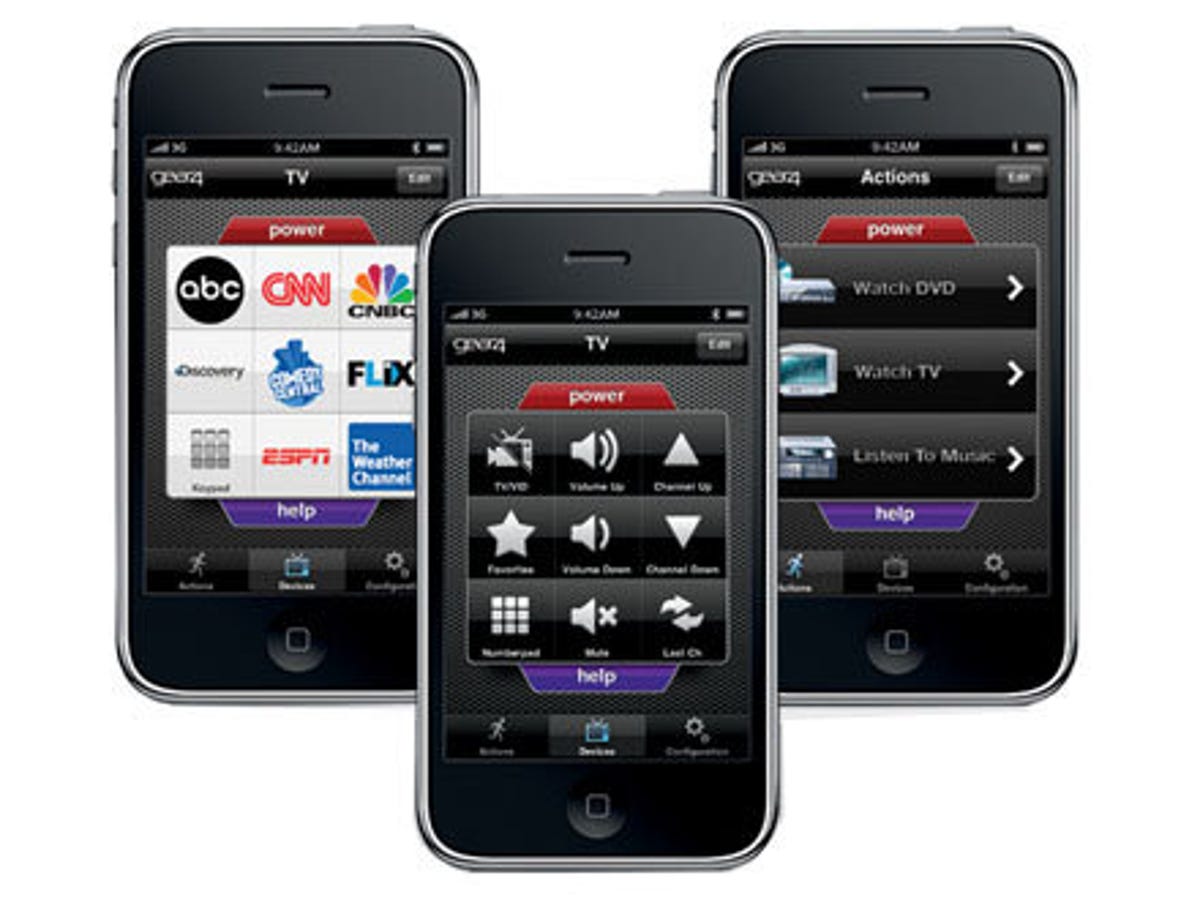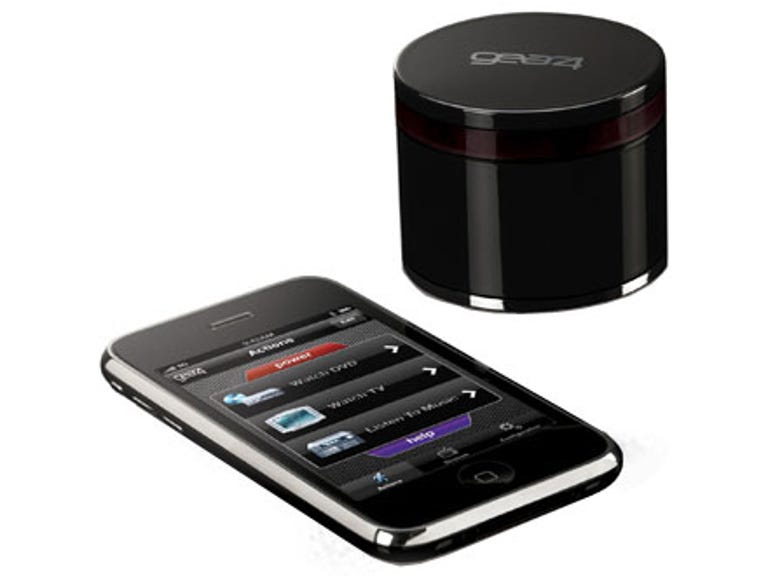 Why You Can Trust CNET
Why You Can Trust CNET Gear4 UnityRemote review: Gear4 UnityRemote
The Gear4 UnityRemote is a smart solution to a very common problem -- too many remotes. This little widget, with the help of an iPhone or iPod touch, will simplify your home-entertainment system.
When you have a whole heap of AV equipment at home, controlling it all soon becomes a huge problem. If you want to watch a Blu-ray or something similar from a media streamer, you need to have at least three remote controls to hand. There's the TV controller, the AV receiver and the player controller that all need to be wrangled into position, fiddled with and switched on, preferably in the right order.
The Good
The Bad
The Bottom Line
Universal remote controls have been around since the TV Dark Ages -- when tellies where 28 inches wide and weighed as much as the moon. The problem is, unless you're just using them to replace one remote control, they tend to be really complicated. We've seen all manner of these things over the years. And while we've loved quite a few of them, we've never found one simple enough to convince us to put our original manufacturer controllers into storage.
Now, Gear4 has sprung up with something called the UnityRemote, which is a universal controller that uses the iPod touch or iPhone as the remote. It comes with a neat, responsive touchscreen as a user interface, and Gear4 handles the infrared commands with a small, hockey-puck-type device.
Looks ace and dead simple to set up
The small, round puck is ideal for the job. When you're initially setting it up, Gear4 suggests you place it as close as possible to the hardware you're controlling. We didn't have an issue with proximity -- even though our AV equipment is located at the end of a Lindy IR sender, the Gear4 hardware picked it all up without problem.
The initial set-up requires you to first pair your iPhone or iPod with the UnityRemote. As you might imagine, Gear4 is something of an expert at Bluetooth, so this works incredibly well and is very simple.
Once paired, you can begin to add your AV devices one by one into the system. This process couldn't be much easier. You simply select the name of the manufacturer and what sort of device it is, then the app sends out a test command via Bluetooth, which the puck receives and transmits to your AV equipment as infrared.
For most devices we tested, this worked first time. If it doesn't, there are several different commands the device can try, and it will rattle through these in no time at all. It's a far simpler system than that found on, say, the Logitech controllers, which require you to program the remote with PC software.
No cables at all
The Gear4 UnityRemote is powered by three AA batteries. These keep the device going for months at a time, and the power-saving feature prolongs battery life. In doing so, it often switches the device off when it's been unused for some time. This is fine once you remember to switch it back on again, but is still likely to catch some people out.
Two control methods
With most universal remotes, there are two approaches you can take. You can either have one controller that does its best to have a button for every popular function of home AV systems, or you can build an 'actions-based system' that remembers what equipment needs to be turns on in order to watch, for example, a Blu-ray.

The great news is that the UnityRemote does both. Because the touchscreen interface of the iPod/iPhone app is so flexible, you can scroll through pages of specific commands for each device. This isn't as confusing as it sounds, and you can customise everything. You can also set up actions that will fire up several pieces of equipment in order.
Lag-free switching
One of the things we were initially worried about was the lag between pressing a button on the iPod, and our TV changing volume or channel. After all, commands go via Bluetooth, get converted to IR then get sent out from the puck. In fact, the delays were minimal. While things don't happen quite as quickly as they do with a proper remote, they are more than quick enough to be usable.
Problems with some set-ups
While the UnityRemote is brilliant at controlling a wide range of devices, there are some things that can confuse it. For example, we wanted to set up an action for playing a Blu-ray, but the process of getting everything to switch on in the right order and at the right time was a little taxing.
Happily, the Gear4 offers every option you're likely to need, including pauses for when you need time for certain pieces of equipment to turn themselves on. While initially this seems like a hard task, it just requires some patience and tweaking to get everything working harmoniously.
The only other glitch we had was with our Onkyo AV receiver. While the first code worked in the set-up test, it wouldn't turn the receiver off. Switching the code to a different one solved the problem, though, and took just a few minutes to troubleshoot.
When the presets don't work
Like all universal remote controls, there are just some functions that aren't preprogrammed into the device. For these, you can simply teach it new remote commands. This is quite handy when you're in a bind, but it does take a fair amount of tinkering.
Customisation also extends to the buttons, which can be configured in any layout you like. You can customise icons, too, which means you can give channel buttons their corresponding logo. It's a much slicker user interface than any other universal remote, thanks to the wonderful iDevice screen and thoughtful UI.
Not limited to AV equipment
Because the Gear4 UnityRemote has a 360-degree IR sender, you can actually use it on any IR device in your room. So if you have IR-controlled lights, the Unity will have no problem sending signals to them, too, as long as they're within a reasonable distance of the main unit.
This is especially appealing for Xbox 360 owners who don't want to pay for that Microsoft remote to get the best out of media playback. The same goes for owners of Media Centre PCs. Because the Gear4 has such a programmable interface, it's slightly better placed to support these sorts of products than a button-based universal remote.
Conclusion
On the face of it, £100 seems like a pretty high price to pay for the Gear4 UnityRemote, especially when you have to supply the remote itself in an iPod touch or iPhone.
The only major problem we have with this system is that you need to have the iPod or iPhone in the same room with you. If your household only has one iPod touch, and your other half has nicked it for their work commute, you might be stuck with no control of your equipment. Still, we dare say this is as good an excuse as any to buy another iPod touch, so everyone who needs to control the TV has one to hand.
This gadget does a better job than most stand-alone remote controllers. We just love the design of the app and the lack of fuss required to get things up and running.
Edited by Emma Bayly
